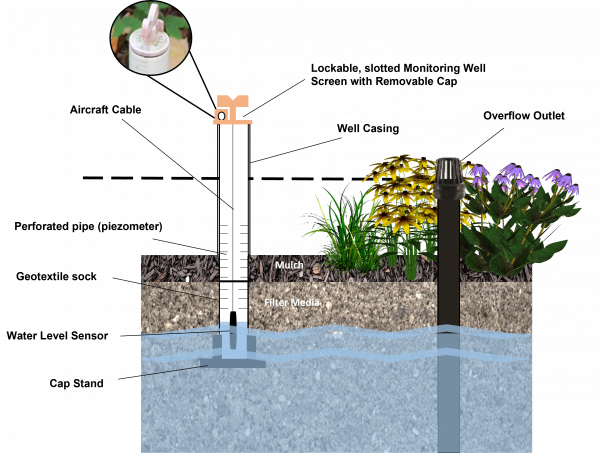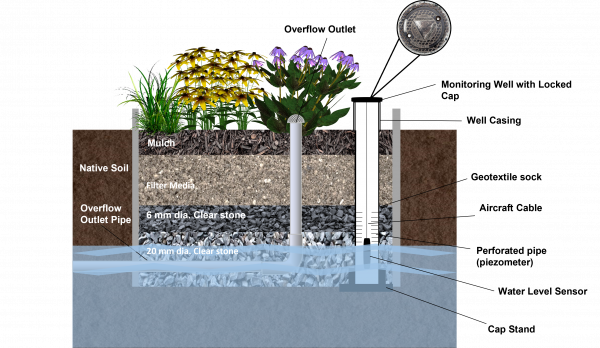Difference between revisions of "Wells"
Dean Young (talk | contribs) |
Dean Young (talk | contribs) |
||
| Line 51: | Line 51: | ||
<imagemap> | <imagemap> | ||
| − | File:Deep monitoring well.png |thumb|600px|Cross-section view of a bioretention cell with a deep monitoring well. For further details click here for [https://sustainabletechnologies.ca/app/uploads/2016/08/LID-IM-Guide-2016-1.pdf STEP's, Low Impact Development Stormwater Management Practice Inspection and Maintenance Guide (Pg. 195 - 204).] <span style="color:red">''A note: The following is an "image map", feel free to explore the image with your cursor and click on highlighted labels that appear to take you to corresponding pages on the Wiki.''</span> | + | File:Deep monitoring well.png |thumb|600px|Cross-section view of a partial infiltration bioretention cell with a deep monitoring well. For further details click here for [https://sustainabletechnologies.ca/app/uploads/2016/08/LID-IM-Guide-2016-1.pdf STEP's, Low Impact Development Stormwater Management Practice Inspection and Maintenance Guide (Pg. 195 - 204).] <span style="color:red">''A note: The following is an "image map", feel free to explore the image with your cursor and click on highlighted labels that appear to take you to corresponding pages on the Wiki.''</span> |
rect 803 892 1650 1174 [[Filter Media|Filter Media]] | rect 803 892 1650 1174 [[Filter Media|Filter Media]] | ||
Revision as of 17:23, 16 June 2022

This article gives tips on the design and installation of monitoring wells into LID practices. It does not address the much deeper wells used to monitor groundwater levels. Monitoring wells are frequently installed on infiltrating systems such as bioretention, bioswales, infiltration trenches and hybrids thereof. The two questions most frequently addressed are:
- How quickly is surface ponding being infiltrated beneath the surface?
- How quickly is the facility draining through exfiltration to native soils and/or through an underdrain?
Shallow wells[edit]
To measure the depth of ponding on the filter media bed surface, and rate at which the ponded water drains, install a shallow well with a water level logger:
- Use a section of perforated pipe or well screen with a geotextile sock around the perforated section that will allow ponded water to enter the well while preventing sediment from accumulating within it.
- Locate the well in the deepest portion of the surface ponding area or where ponding most frequently occurs.
- Measure the depth of the water level sensor in the well, relative to the filter media surface to translate sensor readings into surface ponding depth measurements.
- Ensure there is a solid cap on the bottom of the well to provide a small water reservoir (e.g., 100 mm deep) to keep the water level sensor submerged during dry conditions. This practice also helps with checking calibration of the sensor.
Deep wells[edit]
Many types of LID practices are designed to retain water within an internal water storage reservoir or layer (e.g. full and partial infiltration [[Bioretention|bioretention], stormwater tree trench and [permeable pavements|permeable pavement]] designs, infiltration trenches and chambers, and exfiltration trenches). To facilitate measurement of water level in the internal water storage reservoir or layer and periodically evaluate drainage performance over the operating life cycle of the facility, include a monitoring well located in the lowest elevation portion of the practice or system:
- Include monitoring wells in design drawings and details and install at an appropriate time during construction, or as part of repair work for facilities in need of rehabilitation.
- Ensure the perforated section of the well is located within the internal water storage reservoir or layer only, and that it extends to the bottom elevation of the practice at a minimum.
- Design and install the well so that surface water will not affect water level readings.
- A standard monitoring well casing and cap or monument to protect, secure and provide access to the well should also be included.
- Ensure there is a solid cap on the bottom of the well to provide a small water reservoir (e.g., 100 mm deep) to keep the water level sensor submerged during dry conditions. This practice also helps with checking calibration of the sensor.
- Where possible, wells should be located in areas with little or no vehicular traffic for ease of access.

Monitoring Well Specification[edit]
The monitoring well should be installed during construction in a pervious area within the trench between tree planting areas. The well should be vertical from top to bottom.
| Feature | Notes |
|---|---|
| Material | The pipe should be rigid to prevent bending (e.g. PVC). |
| Diameter | minimum 100 mm |
| Perforations | The perforations may be similar spacing similar to underdrain pipes. Perforations are only required on the bottom third of the pipe. The well should be sealed at the surface to prevent short circuiting of surface water flow along the sides of the well. Bentonite clay is often used for this purpose. |
| Sock | The perforated portion of the pipe should be wrapped with a geotextile sock. Standard geotextile provided with perforated pipe may be used. |
| Bottom/sump | The bottom 100 mm of the well should be capped and free of perforations to provide a small reservoir of water to keep the sensor wet during dry weather. |
| Length | Shallow wells should extend into the filter media by a minimum of 150 mm. Deep wells should extend into the native soil below the facility by a minimum 150 mm. Tops should be above the surface overflow elevation or maximum ponding depth to prevent surface water from entering the well. If the underdrain perforated pipe is installed in a shallow trench below the bottom of the facility, the well should extend 150 mm below the invert of the perforated pipe. |
| Cap | The well should be finished with a lockable cap or standard monitoring well casing and monument to protect, secure and provide access to it. |